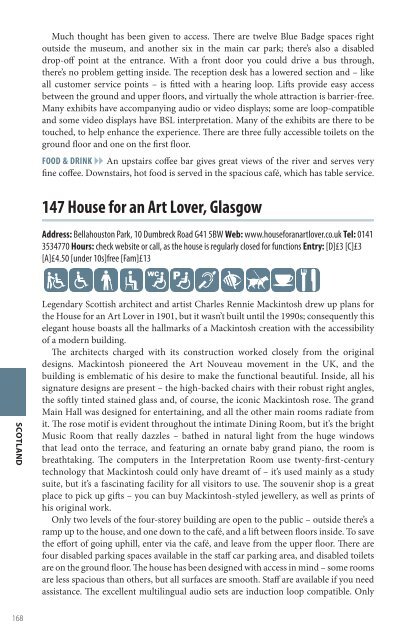Accessible Britain
o4Nb301YbAS
o4Nb301YbAS
Create successful ePaper yourself
Turn your PDF publications into a flip-book with our unique Google optimized e-Paper software.
Much thought has been given to access. There are twelve Blue Badge spaces right<br />
outside the museum, and another six in the main car park; there’s also a disabled<br />
drop-off point at the entrance. With a front door you could drive a bus through,<br />
there’s no problem getting inside. The reception desk has a lowered section and – like<br />
all customer service points – is fitted with a hearing loop. Lifts provide easy access<br />
between the ground and upper floors, and virtually the whole attraction is barrier-free.<br />
Many exhibits have accompanying audio or video displays; some are loop-compatible<br />
and some video displays have BSL interpretation. Many of the exhibits are there to be<br />
touched, to help enhance the experience. There are three fully accessible toilets on the<br />
ground floor and one on the first floor.<br />
FOOD & DRINK aa An upstairs coffee bar gives great views of the river and serves very<br />
fine coffee. Downstairs, hot food is served in the spacious café, which has table service.<br />
147 House for an Art Lover, Glasgow<br />
Address: Bellahouston Park, 10 Dumbreck Road G41 5BW Web: www.houseforanartlover.co.uk Tel: 0141<br />
3534770 Hours: check website or call, as the house is regularly closed for functions Entry: [D]£3 [C]£3<br />
[A]£4.50 [under 10s]free [Fam]£13<br />
SCOTLAND<br />
Legendary Scottish architect and artist Charles Rennie Mackintosh drew up plans for<br />
the House for an Art Lover in 1901, but it wasn’t built until the 1990s; consequently this<br />
elegant house boasts all the hallmarks of a Mackintosh creation with the accessibility<br />
of a modern building.<br />
The architects charged with its construction worked closely from the original<br />
designs. Mackintosh pioneered the Art Nouveau movement in the UK, and the<br />
building is emblematic of his desire to make the functional beautiful. Inside, all his<br />
signature designs are present – the high-backed chairs with their robust right angles,<br />
the softly tinted stained glass and, of course, the iconic Mackintosh rose. The grand<br />
Main Hall was designed for entertaining, and all the other main rooms radiate from<br />
it. The rose motif is evident throughout the intimate Dining Room, but it’s the bright<br />
Music Room that really dazzles – bathed in natural light from the huge windows<br />
that lead onto the terrace, and featuring an ornate baby grand piano, the room is<br />
breathtaking. The computers in the Interpretation Room use twenty-first-century<br />
technology that Mackintosh could only have dreamt of – it’s used mainly as a study<br />
suite, but it’s a fascinating facility for all visitors to use. The souvenir shop is a great<br />
place to pick up gifts – you can buy Mackintosh-styled jewellery, as well as prints of<br />
his original work.<br />
Only two levels of the four-storey building are open to the public – outside there’s a<br />
ramp up to the house, and one down to the café, and a lift between floors inside. To save<br />
the effort of going uphill, enter via the café, and leave from the upper floor. There are<br />
four disabled parking spaces available in the staff car parking area, and disabled toilets<br />
are on the ground floor. The house has been designed with access in mind – some rooms<br />
are less spacious than others, but all surfaces are smooth. Staff are available if you need<br />
assistance. The excellent multilingual audio sets are induction loop compatible. Only<br />
168


